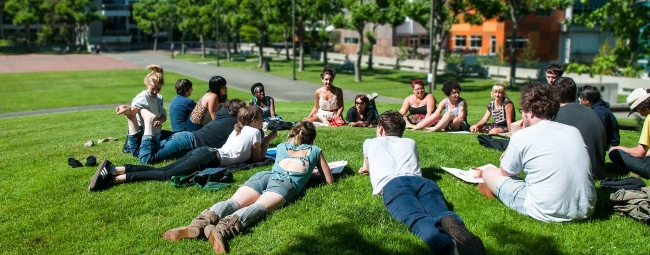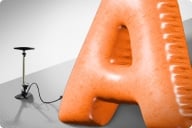You have /5 articles left.
Sign up for a free account or log in.

An outdoor study session at Evergreen State College
Evergreen State College
Assessment can be a dirty word, especially when it comes from the top down, and neither faculty nor students are convinced that it measures anything meaningful. But Evergreen State College’s new assessment – which is its only graduation requirement – has been embraced by both groups as a valuable part of the undergraduate experience. The academic statement assessment asks students to think and write, over and over again throughout their college careers, about what they’ve learned: why have they made the educational choices they have, and what is it all adding up to? The final iteration of the assessment becomes a cover letter or guide to students’ transcripts, offering other institutions and would-be employers particular insight into the document before them.
Fans of the academic statement say it’s much more than that, in that it forces students to become more intentional about the educational and life choices they’re making. That means, in theory, that they’re becoming better human beings – the point of a liberal arts education.
And while the academic statement requirement has been described by those involved in its conception as “very Evergreen” – the Olympia, Wash., public liberal arts college doesn’t use traditional letter grading averages or have typical majors and minors, and its students are overwhelmingly nontraditional -- students, faculty and administrators say there’s no reason it can’t be exported to other institutions dedicated to meaningful assessment models.
“I've learned that having access to an education like this is a massive privilege given to a minority of people throughout history,” said David Skattebo, a 21-year old junior studying education and empowerment at Evergreen, where he transferred from a private institution in the Midwest. “I've learned I want to use my education to prepare me to be an agent of change in the world. I don't know if this realization would have jumped out at me with such clarity had I not been told to critically reflect on my experiences and my education in a formal way like the academic statement.”
Skattebo’s current academic statement offers additional insight into how alienated he felt from higher education before coming to Evergreen, and how his experience there has changed his world view.
“Not long ago, I felt the oppressive state of higher education and the competitive economy made pursuing my degree futile. I had no clue as to how I should participate in society,” he wrote. “Within two quarters of returning to school, through community service and exploration of critical theory, I've found empowerment and motivation that has opened my future. This amazes me.”
He continues: “I feel more aware of the skills I have to offer and how I can use them both as a part of the struggle for social and ecological justice and as a means to meet my needs. I feel I have (and will continue to gain) a deeper understanding of the threats against the planet and the ways these issues are interconnected. Whether I'm a teacher, an organizer, a writer, or a farmer, or all these things, I finally feel the work I will set my heart, head, and hands to will have meaning beyond myself because of this understanding and intention.”
Academic statements aren’t tomes. They’re no more than 750 words, which frequently makes the assignment more challenging; it can be harder to “write short,” said Michael Zimmerman, provost, who helped oversee the academic statement program’s launch. This is the first year it’s been required of all new students, and existing students are encouraged to participate, brainstorming each fall with faculty mentors and drafting a new version each year.
And, despite initial faculty concerns that students’ statements might all sound similar, Zimmerman said the statements so far sound as unique as the students who write them.
Edward Riley’s academic statement, for example, reads entirely differently from Skattebo’s. That’s partly a function of how different they are – Riley is 50-year-old junior enrolled in a community-based learning and action program who went back to school following the recession and struggles with substance abuse.
But it’s also because length is just about the only guideline for the academic statement. Students are free, and encouraged, to write whatever they want to about their education.
“For me, simply, stated, education is transformation,” reads Riley’s statement. “In what form, and how that transformation occurs is purely an individual experience. In my case, that transformation is, and continues to be profound, but like any transformation, it has not come without challenges or setbacks. Initially it required that, through education, I would somehow be transported to a better, more fulfilling life, and that previous lifelong struggles would be wiped clean.”
Now, Riley says, faith in that process has “given way to knowledge, knowledge based in facts, facts based on the personal experience that education is, and will continue, to transform the who and what I am.”
That’s been “mirrored” in fellow students, he says. “Transformation of the meth addict who became a STEM scholar. Transformation of the prisoner, who, forever breaking the cycle of crime, earned his degree while behind bars. Transformation of the downtrodden, desperate and degraded that, through the power of education, have become confident, secure and productive individuals who in turn create confident, secure and productive communities.”
“Liberation” reappears throughout Skattebo’s statement, as does “transformation” throughout Riley’s. Other Evergreen students have their own synonyms for education, and that’s the idea. But at the same time, a common theme emerges in nearly all students’ statements, said Nancy Koppelman, an American studies professor who volunteered to lead the academic assessment program. She said the statement grew out of intensive faculty discussions about the need for a new assessment that would complement the college’s liberal arts mission and values. Faculty approved the academic statement proposal in 2011 and it had been offered as a voluntary essay contest opportunity since that time. Of course, now it’s mandatory.
“[What] strikes me is that there’s an organic connection between their concerns as private human beings living their lives, and trying to figure out their lives, and trying to figure out their work,” Koppelman said.
In other words, she said, “How can the work I do in the world reflect who I am? How can what I do reflect what I say and what I am?”
Koppelman said she doesn't believe that the desire to connect one’s work to one’s values is unique to Evergreen students – and for that reason, the assessment model could be adapted to any kind of institution. But the academic statement does reflect Evergreen’s dedication to the idea that students “know what’s valuable to them right now.” The proof of that is in how “moving” the statements are, she said.
Students write the first version of their academic statement during orientation during the first week of classes. Then, each fall for the following three years, students revise their statements to reflect who they are as students and people at that moment. They get some mentoring from faculty during a six-hour period of Evergreen’s fall program, but the statement is largely an independent endeavor. The statements aren’t graded, but rather filed electronically with the college. The final draft, written during a student’s final year at Evergreen, gets filed with his or her transcript and helps explain the narrative grading system and interdisciplinary program-focused curriculum.
Koppelman said the academic statement initiative was “entirely faculty-driven.” But it did have an administrative cheerleader of sorts, in Zimmerman, who came to the college just as faculty were rethinking assessment at Evergreen. The provost said he was inspired by the idea of a “conspiracy of voluntary silence” among liberal arts faculty and administrators (the term was coined by Carol Geary Schneider, president of the American Association of Colleges and Universities) – and consequently inspired by the idea that Evergreen’s new assessment should be firmly and proudly rooted in the liberal arts.
Zimmerman said he’s a trained scientist, and that he “loves” quantitative data, nowadays more typically associated with systematic assessment. But there are some things it just can’t measure, he said.
“The intrinsic value [of the academic statement] is it requires students to think about what they’re doing instead of just floating. If the idea of being reflective is not a deep and central part of higher education then we have a big problem.”
Debra Humphreys, vice president of policy and public engagement for AAC&U, praised Evergreen’s new assessment and, in an email, said it’s one of a growing number of ongoing, alternative assessment models: “I think that many institutions are trying different approaches to reach similar ends -- helping to be more transparent and intentional about what various learning experiences add up to. Reflection on learning is a principle that is essential to getting students to achieve the learning they need. Evergreen's approach fits perfectly for their culture but other campuses are doing the same but through other approaches, for instance e-portfolios.”
There are potential drawbacks to such nontraditional forms of assessment. Among them is whether what a student wrote in college would accurately represent him or her to potential employers or graduate schools years or even decades later. Asked whether he minded that something he’d written as a 21- or 22-year-old would be attached to his transcript going forward, whether he wanted it to or not, Skattebo reiterated via email what he saw as the value of the assessment: “If anything, it's a great opportunity to introduce who I am, why I went to Evergreen, and what I got out of it. The academic statement puts one of my strongest talents, my writing, at the front page of my talent. So I have no worries.”
He added: “It's way better than the pile of meaningless numbers I would have had from my previous, much more traditional, college.”
Zimmerman said students have so far embraced the assessment with similar enthusiasm – even many existing students who are not required to write them. And faculty members have said the statements already have changed the way they think about their teaching, and what students need from them, he said.
Koppelman agreed that the academic statement has changed how she sees her students, and herself as a teacher.
“I’ve learned that students need their faculty and their colleges to acknowledge and make time for them to think carefully about what they’re doing,” she said via email. “They need faculty to help them learn how to think about how their education will interface with the world. Students tend to be both practical and idealistic. They want to their education to matter in practical ways: to help them develop skills, funds of knowledge, and conceptual connections that will demystify the world and help them learn how to navigate and change it. But they also want their education to matter in ethical ways: to help them understand the implications of knowledge, and to better face the unpredictable but certain-to-arise dilemmas, personal and political, that they face as a function of simply being human.”
She continued: “It turns out there’s nothing simple about being human. Embracing that complexity and doing so with courage and what jazz musicians call ‘chops’ is a great and virtuous skill. ‘Interfacing with the world’ here means doing so with both thought and action.”









